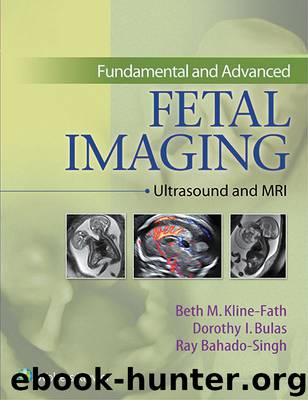Fundamental and Advanced Fetal Imaging: Ultrasound and MRI by Kline-Fath Beth & Bahado-Singh Ray & Bulas Dorothy

Author:Kline-Fath, Beth & Bahado-Singh, Ray & Bulas, Dorothy
Language: eng
Format: epub
Publisher: LWW
Published: 2014-09-08T16:00:00+00:00
FIGURE 12.3-4: Imaging of the Fourth Ventricle A: Once Blake pouch fenestrates, its neck or Blake metapore (dashed oval) becomes the foramen of Magendie. The choroid plexus in the roof of the fourth ventricle (short arrow) now appears to be “in the cisterna magna.” B: On sonography at 19 weeks, fetus having an apparently normal vermis was seen superiorly (not shown). Modified axial sonogram in the same fetus demonstrating normal appearances of the communication between the fourth ventricle and the subarachnoid space (arrow), in keeping with the foramen of Magendie. C: Sagittal fetal MRI study at 21 weeks’ gestation in the same fetus showing a small “defect” (arrow) gap between the inferior vermis and the brainstem. D: Follow-up sonography at 26 weeks showed normal appearances of the posterior fossa with an intact vermis. Postnatal sagittal sonography on day 1 of life demonstrates an apparently complete vermis (arrow) with no evidence of an increased tegmento-vermian angle. This baby had normal development at 2 years of age. (A, from Robinson AJ, Goldstein R. The cisterna magna septa: vestigial remnants of Blake’s pouch and a potential new marker for normal development of the rhombencephalon. J Ultrasound Med. 2007;26:83–95, with permission of the American Institute of Ultrasound in Medicine. B–D, from Robinson AJ, Blaser S, Toi A, et al. The fetal cerebellar vermis: assessment for abnormal development by ultrasonography and magnetic resonance imaging. Ultrasound Q. 2007;23:211–223, with permission of Wolters Kluwer Health.)
In the literature, the phrase “a posterior fossa cyst communicating with the 4th ventricle” is often used to describe cystic malformations of the posterior fossa; however, this is actually a description of the normal anatomy. What is abnormal is the size of the posterior fossa “cyst,” not the fact that it communicates with the fourth ventricle. The Dandy-Walker “cyst” is in fact Blake pouch, which expands to fill the subarachnoid space of the cisterna magna.18 The cisterna magna septa are not typically seen in cystic malformations of the posterior fossa24 because as Blake pouch expands, its walls, that is the septa, are displaced laterally and can become indistinguishable from the walls of the cisterna magna, although often the true subarachnoid space of the cisterna magna is still visible very laterally beyond the septa. Additionally seen in the literature is the description of the fourth ventricle “widely communicating with the cisterna magna.” Again, it is not actually the cisterna magna with which the fourth ventricle is in communication; it is in communication with Blake pouch, which in turn is itself contained within the cisterna magna.
CYSTIC ANOMALIES
Blake Pouch Cyst and Persistent Blake Pouch
Incidence: This is a rare diagnosis. The largest study to date of all posterior fossa collections (including Blake pouch cyst, mega cisterna magna, Dandy-Walker continuum, posterior fossa arachnoid cysts) had a total of 105 fetuses over a 10-year period in two referral centers for prenatal diagnosis.25
Embryology and Genetics: In persistent Blake pouch (Fig. 12.3-5), there is thought to be inadequate fenestration of both Blake pouch and the foramen of Luschka, leading to imbalance
Download
This site does not store any files on its server. We only index and link to content provided by other sites. Please contact the content providers to delete copyright contents if any and email us, we'll remove relevant links or contents immediately.
Periodization Training for Sports by Tudor Bompa(8171)
Why We Sleep: Unlocking the Power of Sleep and Dreams by Matthew Walker(6618)
Paper Towns by Green John(5092)
The Immortal Life of Henrietta Lacks by Rebecca Skloot(4526)
The Sports Rules Book by Human Kinetics(4296)
Dynamic Alignment Through Imagery by Eric Franklin(4118)
ACSM's Complete Guide to Fitness & Health by ACSM(3989)
Kaplan MCAT Organic Chemistry Review: Created for MCAT 2015 (Kaplan Test Prep) by Kaplan(3940)
Introduction to Kinesiology by Shirl J. Hoffman(3726)
Livewired by David Eagleman(3685)
The Death of the Heart by Elizabeth Bowen(3553)
The River of Consciousness by Oliver Sacks(3542)
Alchemy and Alchemists by C. J. S. Thompson(3451)
Bad Pharma by Ben Goldacre(3357)
Descartes' Error by Antonio Damasio(3230)
The Emperor of All Maladies: A Biography of Cancer by Siddhartha Mukherjee(3068)
The Gene: An Intimate History by Siddhartha Mukherjee(3048)
The Fate of Rome: Climate, Disease, and the End of an Empire (The Princeton History of the Ancient World) by Kyle Harper(3003)
Kaplan MCAT Behavioral Sciences Review: Created for MCAT 2015 (Kaplan Test Prep) by Kaplan(2941)
